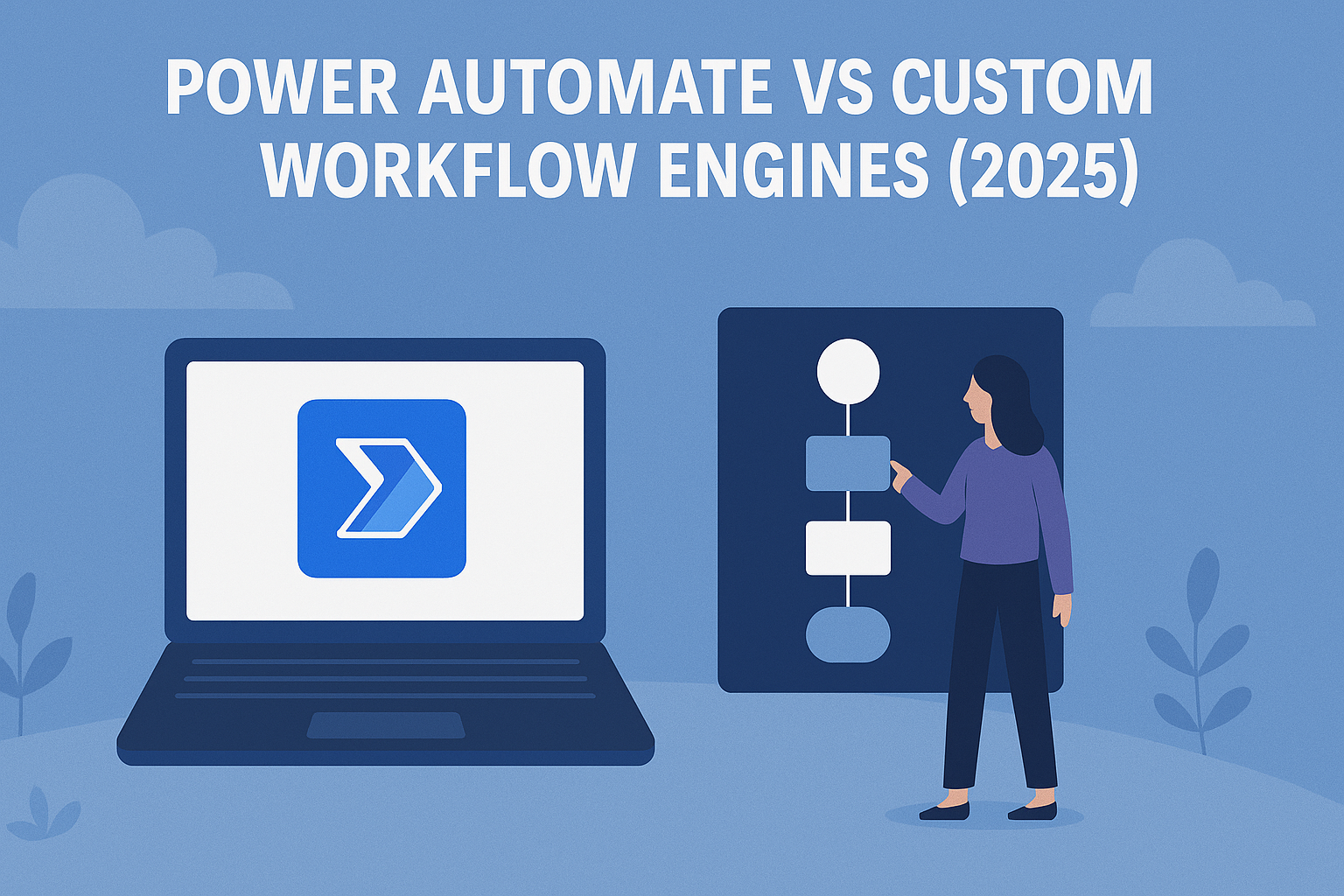In 2025, workflow automation is not a luxury—it’s a necessity. Businesses of all sizes are adopting automation tools to optimize operations, reduce manual errors, and accelerate digital transformation. Two major players dominate the discussion: Microsoft Power Automate and Custom Workflow Engines built using platforms like Node.js, .NET, or Python.
In this blog, we’ll compare Power Automate vs custom workflow development, explore top use cases, share real-world coding examples, and help you decide what’s best for your business.
Why Automation Matters in 2025
Automation isn’t just about replacing manual work—it’s about rethinking how businesses operate. In today’s enterprise environments, companies are increasingly embracing flexible tools that support everything from low-code workflows to highly customized process automation. This shift reflects a growing demand for scalable solutions that can integrate across cloud-native and legacy systems alike.
We’re seeing a move toward platforms that cater to both citizen developers and experienced engineers, helping organizations unify operations, enhance collaboration, and respond faster to market needs. Whether it’s simplifying task automation, enabling cross-platform integrations, or building custom engines tailored to unique challenges, the spectrum of tools in 2025 offers something for every business type and size.
What is Microsoft Power Automate?
Power Automate is a cloud-based low-code platform allowing users to build workflows across Microsoft 365, SharePoint, Teams, and 600+ services using prebuilt connectors.
Features:
- Drag-and-drop flow builder
- AI document processing
- Prebuilt automation templates
- Integration with Microsoft ecosystem
Pros:
- Great for non-developers
- Fast deployment
- Rich Microsoft integration
Cons:
- Limited to supported connectors
- Cost can increase with usage
- Restricted customization for complex workflows
Real-World Example: Auto-send Email on SharePoint Update
Steps:
- Trigger: “When an item is created” in SharePoint
- Action: “Send an email notification” via Outlook
What is a Custom Workflow Engine?
Custom workflow engines are developer-built automation systems tailored for complex, highly scalable tasks. Built with tools like Node.js, Python, or Camunda, they support extensive integration, logic, and event-driven architecture.
Features:
- Total control of business logic
- Scalable design with Kubernetes/Docker
- Open-source libraries (e.g., Temporal, Apache Airflow)
Pros:
- Highly customizable
- No licensing fees
- Performance-optimized workflows
Cons:
- Requires developer expertise
- Higher initial development time
Real-World Example (Node.js): Process Incoming Webhook Data
const express = require('express');
const app = express();
app.use(express.json());
app.post('/webhook', (req, res) => {
const data = req.body;
// Business logic: filter, transform, store, trigger next action
console.log('Processing:', data);
res.status(200).send('Webhook received');
});
app.listen(3000, () => console.log('Workflow engine running'));Feature Comparison: Power Automate vs Custom Workflow Engines
| Feature | Power Automate | Custom Workflow Engine |
| Development Speed | Fast (drag-and-drop) | Slower (coding required) |
| Custom Logic | Limited | Unlimited |
| Cost | Subscription-based | Infrastructure-only |
| Scaling | Medium (per plan limits) | High (self-managed) |
| Integration Depth | Prebuilt connectors | Fully programmable |
| Security Flexibility | Microsoft defaults | Fully configurable |
Use Case Comparison
| Use Case | Best Tool |
| Simple office task automation | Power Automate |
| Complex business logic | Custom Workflow Engine |
| Integration with Microsoft apps | Power Automate |
| Event-driven microservices | Custom Workflow Engine |
| High-volume data processing | Custom Workflow Engine |
Security Considerations
Power Automate:
- Inherits Microsoft 365 security model
- RBAC, encrypted flows, audit logs
Custom Engines:
- Define your own auth with OAuth2/JWT
- Use HTTPS, encrypt stored data, audit APIs
- Integration with tools like HashiCorp Vault or Azure Key Vault
Testing & Maintenance
Power Automate:
- Built-in flow testing tools
- Run history & logging in UI
Custom Workflow:
- Unit tests with Jest, Mocha
- Integration tests using Postman/Newman
- Logging with Winston or Serilog
Trends Driving Automation in 2025
- 40% increase in low-code adoption
- 60% of DevOps teams use hybrid automation models
- Rise of AI-powered automation: GPT agents + flows
- Containers and Kubernetes standard for custom workflow scalability
Final Thoughts
Both Power Automate and custom workflow engines have their place. Choosing the right tool depends on:
- Your technical resources
- The complexity of your workflows
- Integration requirements
- Future scalability plans
Choose Power Automate if:
- You need to automate simple, repetitive business processes
- You’re embedded in Microsoft environments
- You want quick results with minimal code
Choose a Custom Workflow Engine if:
- You need full control and advanced custom logic
- You’re building scalable, event-driven apps
- You require integration beyond standard connectors
Pro Tip: Start prototyping with Power Automate, then scale into a custom workflow as your needs evolve.
Need a downloadable flow template, CI/CD guide, or sample engine repo? Just ask!


